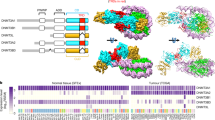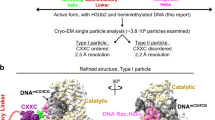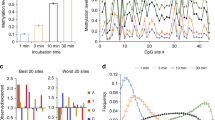Abstract
The PWWP domain is a weakly conserved sequence motif found in >60 eukaryotic proteins, including the mammalian DNA methyltransferases Dnmt3a and Dnmt3b. These proteins often contain other chromatin-association domains. A 135-residue PWWP domain from mouse Dnmt3b (amino acids 223–357) has been structurally characterized at 1.8 Å resolution. The N-terminal half of this domain resembles a barrel-like five-stranded structure, whereas the C-terminal half contains a five-helix bundle. The two halves are packed against each other to form a single structural module that exhibits a prominent positive electrostatic potential. The PWWP domain alone binds DNA in vitro, probably through its basic surface. We also show that recombinant Dnmt3b2 protein (a splice variant of Dnmt3b) and two N-terminal deletion mutants (Δ218 and Δ369) have approximately equal methyl transfer activity on unmethylated and hemimethylated CpG-containing oligonucleotides. The Δ218 protein, which includes the PWWP domain, binds DNA more strongly than Δ369, which lacks the PWWP domain.
This is a preview of subscription content, access via your institution
Access options
Subscribe to this journal
Receive 12 print issues and online access
$209.00 per year
only $17.42 per issue
Buy this article
- Purchase on SpringerLink
- Instant access to full article PDF
Prices may be subject to local taxes which are calculated during checkout






Similar content being viewed by others
References
Bestor, T.H. The DNA methyltransferases of mammals. Hum. Mol. Genet. 9, 2395–2402 (2000).
Wade, P.A. Methyl CpG binding proteins: coupling chromatin architecture to gene regulation. Oncogene 20, 3166–3173 (2001).
Jones, P.A. & Takai, D. The role of DNA methylation in mammalian epigenetics. Science 293, 1068–1070 (2001).
Yoder, J.A., Soman, N.S., Verdine, G.L. & Bestor, T.H. DNA (cytosine-5) methyltransferases in mouse cells and tisssues. Studies with a mechanism-based probe. J. Mol. Biol. 270, 385–395 (1997).
Pradhan, S., Bacolla, A., Wells, R.D. & Roberts, R.J. Recombinant human DNA (cytosine-5) methyltransferase. I. Expression, purification, and comparison of de novo and maintenance methylation. J. Biol. Chem. 274, 33002–33010 (1999).
Fatemi, M., Hermann, A., Pradhan, S. & Jeltsch, A. The activity of the murine DNA methyltransferase Dnmt1 is controlled by interaction of the catalytic domain with the N-terminal part of the enzyme leading to an allosteric activation of the enzyme after binding to methylated DNA. J. Mol. Biol. 309, 1189–1199 (2001).
Dong, A. et al. Structure of human DNMT2, an enigmatic DNA methyltransferase homolog that displays denaturant-resistant binding to DNA. Nucleic Acids Res. 29, 439–448 (2001).
Okano, M., Xie, S. & Li, E. Cloning and characterization of a family of novel mammalian DNA (cytosine-5) methyltransferases. Nature Genet. 19, 219–220 (1998).
Gowher, H. & Jeltsch, A. Enzymatic properties of recombinant Dnmt3a DNA methyltransferase from mouse: the enzyme modifies DNA in a non-processive manner and also methylates non-CpG sites. J. Mol. Biol. 309, 1201–1208 (2001).
Li, E., Bestor, T.H. & Jaenisch, R. Targeted mutation of the DNA methyltransferase gene results in embryonic lethality. Cell 69, 915–926 (1992).
Okano, M., Bell, D.W., Haber, D.A. & Li, E. DNA methyltransferase Dnmt3a and Dnmt3b are essential for de novo methylation and mammalian development. Cell 99, 247–257 (1999).
Finnegan, E.J., Peacock, W.J. & Dennis, E.S. Reduced DNA methylation in Arabidopsis thaliana results in abnormal plant development. Proc. Natl. Acad. Sci USA 93, 8449–8454 (1996).
Kakutani, T., Jeddeloh, J.A., Flowers, S.K., Munakata, K. & Richards, E.J. Developmental abnormalities and epimutations associated with DNA hypomethylation mutations. Proc. Natl. Acad. Sci. USA 93, 12406–12411 (1996).
Ronemus, M.J., Galbiati, M., Ticknor, C., Chen, J. & Dellaporta, S.L. Demethylation-induced developmental pleiotropy in Arabidopsis. Science 273, 654–657 (1996).
Bird, A.P. & Wolffe, A.P. Methylation-induced repression — belts, braces, and chromatin. Cell 99, 451–454 (1999).
Riggs, A.D. & Pfeifer, G.P. X-chromosome inactivation and cell memory. Trends Genet. 8, 169–174 (1992).
Shemer, R. & Razin, A. In Epigenetic mechanisms of gene regulation (eds Russo, V.E.A., Martienssen, R.A. & Riggs, A.D.) 215–229 (Cold Spring Harbor Laboratory Press, New York; 1996).
Siegfried, Z. & Cedar, H. DNA methylation: a molecular lock. Curr. Biol. 7, R305–R307 (1997).
Xie, S., Wang, Z., Okano, M. & Li, E. Cloning, expression and chromosome locations of the human DNMT3 gene family. Gene 236, 87–95 (1999).
Xu, G. et al. Chromosome instability and immunodeficiency syndrome caused by mutations in a DNA methyltransferase gene. Nature 402, 187–191 (1999).
Robertson, K. et al. The human DNA methyltransferases (DNMTs) 1, 3a and 3b: coordinate mRNA expression in normal tissues and overexperssion in tumors. Nucleic Acids Res. 27, 2291–2298 (1999).
Saito, Y. et al. Expression of mRNA for DNA methyltransferases and methyl-CpG-binding proteins and DNA methylation status on CpG islands and pericentromeric satellite regions during human hepatocarcinogenesis. Hepatology 33, 561–568 (2001).
Kanai, Y., Ushijima, S., Kondo, Y., Nakanishi, Y. & Hirohashi, S. DNA methyltransferases expression and DNA methylation of CpG islands and pericentromeric satellite regions in human colorectal and stomach cancers. Int. J. Cancer 91, 205–212 (2001).
Mizuno, S. et al. Expression of DNA methyltransferases DNMT1, 3a, and 3b in normal hematopoiesis and in acute chronic myelogenous leukemia. Blood 97, 1172–1179 (2001).
Bachman, K.E., Rountree, M.R. & Baylin, S.B. Dnmt3a and Dnmt3b are transcriptional repressors that exhibit unique localization properties to heterochromatin. J. Biol. Chem. 276, 32282–32287 (2001).
Fuks, F., Burgers, W.A., Godin, N., Kasai, M. & Kouzarides, T. Dnmt3a binds decaetylases and is recruited by a sequence-specific repressor to silence transcription. EMBO J. 20, 2536–2544 (2001).
Aoki, A. et al. Enzymatic properties of de novo type mouse DNA (cytosine-5) methyltransferases. Nucleic Acids Res. 29, 3506–3512 (2001).
Stec, I., Nagl, S., van Ommen, G. & Dunnen, J. The PWWP domain: a potential protein-protein interaction domain in nuclear proteins influencing differentiation? FEBS Lett. 473, 1–5 (2000).
Izumoto, Y., Kuroda, T., Harada, H., Kishimoto, T. & Nakamura, H. Hepatoma-derived growth factor belongs to a gene family in mice showing significant homology in the amino terminus. Biochem. Biophys. Res. Commun. 238, 26–32 (1997).
Stec, I. et al. WHSC1, a 90 kb SET domain-containing gene, expressed in early development and homologous to a Drosophila dysmorphy gene maps in the Wolf-Hirschhorn syndrome critical region and is fused to IgH in t(4;14) multiple myeloma. Hum. Mol. Genet. 7, 1071–1082 (1998).
Ramsahoye, R.H. et al. Non-CpG methylation is prevalent in embryonic stem cells and may be mediated by DNA methyltransferase 3a. Proc. Natl. Acad. Sci. USA 97, 5237–5242 (2000).
Flynn, J., Glickman, J.F. & Reich, N.O. Murine DNA cytosine-C5 methyltransferase: pre-steady- and steady-state kinetic analysis with regulatory DNA sequences. Biochemistry 35, 7308–7315 (1996).
Holm, L. & Sander, C. Protein structure comparison by alignment of distance matrices. J. Mol. Biol. 233, 123–138 (1993).
Bottomley, M.J. et al. The SAND domain structure defines a novel DNA-binding fold in transcriptional regulation. Nature Struct. Biol. 8, 626–633 (2001).
Selenko, P. et al. SMN Tudor domain structure and its interaction with the Sm proteins. Nature Struct. Biol. 8, 27–31 (2001).
Marmorstein, R. Protein modules that manipulate histone tails for chromatin regulation. Nature Rev. Mol. Cell Biol. 2, 422–432 (2001).
Hateboer, G. et al. BS69, a novel adenovirus E1A-associated protein that inhibits E1A transactivation. EMBO J. 14, 3159–3169 (1995).
Thompson, K.A. et al. BR140, a novel zinc-finger protein with homology to the TAF250 subunit of TFIID. Biochem. Biophys. Res. Commun. 198, 1143–1152 (1994).
Rea, S. et al. Regulation of chromation structure by site-specific histone H3 methyltransferases. Nature 406, 593–599 (2000).
Nakayama, J., Rice, J. C., Strahl, B. D., Allis, C. D. & Grewal, S. I. Role of histone H3 lysine 9 methylation in epigenetic control of heterochromation assembly. Science 292, 110–113 (2001).
Jeanmougin, F., Wurtz, J. M., Le Douarin, B., Chambon, P. & Losson, R. The bromodomain revisited. Trends Biochem. Sci. 22, 151–153 (1997).
Dhalluin, C. et al. Structure and ligand of a histone acetyltransferase bromodomain. Nature 399, 491–496 (1999).
Wojciak, J.M. & Clubb, R.T. Finding the function buried in SAND. Nature Struct. Biol. 8, 568–570 (2001).
Otwinowski, Z. & Minor, W. Processing of X-ray diffraction data collected in oscillation mode. Methods Enzymol. 276, 307–326 (1997).
Terwilliger, T.C. & Berendzen, J. Automated MAD and MIR sructure solution. Acta Crystallogr. D 55, 849–861 (1999).
Terwilliger, T.C. Maximum likelihood density modification. Acta Crystallogr. D 56, 965–972 (2000).
Jones, T.A. & Kjeldgard, M. Electron-density map interpretation. Methods Enzymol. 277, 173–208 (1997).
Brünger, A.T. X-PLOR. A system for X-ray crystallography and NMR, version 3.1 (Yale University, New Haven; 1992).
Carson, M. Ribbons. Methods Enzymol. 277, 493–505 (1997).
Nicholls, A., Sharp, K.A. & Honig, B. Protein folding and association: insights from the interfacial and thermodynamic properties of hydrocarbons. Protein Struct. Funct. Genet. 11, 281–296 (1991).
Palombo, F. et al. GTBP, a 160-kilodalton protein essential for mismatch-binding activity in human cells. Science 268, 1912–1914 (1995).
Min, J., Landry, J., Sternglanz, R. & Xu, R.-M. Crystal structure of a SIR2 homolog–NAD complex. Cell 105, 269–279 (2001).
Acknowledgements
We thank E. Li for providing mouse Dnmt3b2 cDNA, S. Pradhan for providing full-length Dnmt1; K.D. Wilkinson for help with analysis of DNA binding titration curves; P. Kearney for constructing overexpression plasmids; and L. Zhou, J.R. Horton, D. Schneider and R.M. Sweet for help with X-ray data collection. We also thank R.M. Blumenthal, T.H. Bestor and P.A. Wade for their critical comments on the manuscript. The study was supported in part by the National Institutes of Health grant to X.C.
Author information
Authors and Affiliations
Corresponding author
Ethics declarations
Competing interests
The authors declare no competing financial interests.
Rights and permissions
About this article
Cite this article
Qiu, C., Sawada, K., Zhang, X. et al. The PWWP domain of mammalian DNA methyltransferase Dnmt3b defines a new family of DNA-binding folds. Nat Struct Mol Biol 9, 217–224 (2002). https://doi.org/10.1038/nsb759
Received:
Accepted:
Published:
Issue Date:
DOI: https://doi.org/10.1038/nsb759



